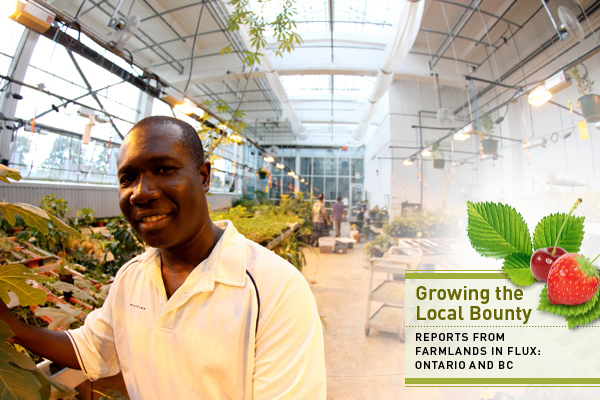It's the lunch rush at The Stop, and chef Scott MacNeil is cursing the scalloped potatoes.
He calls out to the servers -- "You gotta wait five minutes!" -- standing on the other side of the kitchen's swinging door with half-filled plates. As MacNeil prepares another huge baking pan for the oven he fields questions from a group of nine food bank directors and employees.
"How's the day going?" asks one of the visitors, flattened against a stainless steel counter in the crowded kitchen.
"Busy," he replies. He is a few volunteers short today, and his attempt to pull off a quick batch of creamy, cheesy spuds didn't turn out well. "That's the last time I'll try that," he says. "Takes way too long."
Someone else wonders why there is plated service here, instead of having everybody line up. "It's the most efficient," MacNeil says (the lunch rush is typically 200 people over the course of an hour and a half). "Plus, we don't do lineups because we want to foster a sense of dignity here."
More than just a hand-out
When The Stop Community Food Centre first opened its doors in Toronto's Davenport West neighbourhood in the early '70s, it was one of the first food banks in the entire city. Over the past 11 years it's grown to be something much more. Along with the emergency food bank service -- a three-day supply of food, twice a month -- members can drop in for a meal four days a week, grow their own vegetables in a community garden, buy discounted produce at a weekly farmers' market, or take cooking classes.
While The Stop is rooted in providing food to those who can't afford it, it works on the premise that without food infrastructure, viable farms, civic engagement and personal empowerment, food banks are simply a stop-gap measure in the fight to eradicate hunger.
The organization's ability to harness a growing interest in local food has allowed them to not only boost their own programming, but also build local food infrastructure. The model is the envy of foodies and social activists alike, and a case study for municipalities in Ontario and beyond.
Which is why tour groups like this one, from the North York Harvest food bank, show up weekly to see how it's done. North York Harvest is the largest food bank in the city, serving approximately 11,000 people per month through 60 neighbourhood centres. Nation-wide food bank use increased 17.5 per cent in 2009, compared to the year before. Approximately 800,000 people used a food bank last year, many for the first time.
"We don't see the need for food banks ending in the near future," says The Stop's program director, Kathryn Scharf. "But what we are trying to do here is create a tiny microcosm of a food system."
'It allows us to connect with each other'
A secure food system is defined broadly as one in which everyone has access to healthy, sustainable food all of the time. Organizations working on food security tend to veer off in two directions, working on either the access part, or the sustainability part, often leading to a tense division depending on who you prioritize, says Scharf.
The Stop's flagship building, located on the first floor of a plain brick low-rent apartment tower, houses its low-income programming and The Stop's administrative offices. Here, the primary goal is access -- feeding hungry people.
In the dining room, where the tour group gets to sample the lunch (scalloped potatoes -- which turned out great -- mixed green salad, and a swiss chard, butternut squash, leek and sausage stir-fry) dozens of flags hang from the ceiling, representing the diversity of its members. On the walls are posters advertising pre-natal health classes and The Stop's popular Wednesday pizza night, featuring homemade pies baked in a wood-fired oven outside. There's also a digital counter, deli-style, so people can have a meal while they wait for their number to come up at the food bank.
Through the dining room doors is the foyer where donated food is handed out. Monday is usually a busy day, says volunteer Sherifa Elkdaen, because they have to unload donations as well as fill orders. Like many of the volunteers, she is also a member. "As a team, we do a tremendous amount for the community, through advocacy and the community centre," she says. "It allows us to connect with each other."
Inside the food bank's dry storage room, there is a random assortment of unperishables: crackers, boxes of mac and cheese, baby food, and six-pound tins of Wendy's brand crushed tomatoes. But there's also always featured fresh produce; this month they have tomatillos and corn from one of The Stop's community gardens. They run two community gardens, Earlscourt and Hillcrest, and also get free or low-cost food for its programs through its new satellite site, The Green Barn.
The Green Barn an oasis for foodies
This site represents the other side of the division that Scharff talked about -- the sustainability side.
Located just a 10-minute drive from The Stop, in Toronto's midtown, the Green Barn is located in a real barn -- though it's one that once held streetcars, not cows. It's part of the the Wychwood Barn development, which opened in 2008 as a mixed housing, artists' studio and office space. It's a beautiful building, with high, vaulted ceilings, lots of glass and heavy wood beams. The Stop's share of the space here includes an office, as well as a greenhouse, sheltered garden, community kitchen and year-round, covered farmers' market.
In the summer, it features vendors with mostly organic produce; in the winter, artisan products like chocolate and cheeses dominate. Scharf acknowledges that it's a high-end market, out of reach of the Davenport community.
"But it provides a valuable role supporting farmers and it certainly builds that kind of community around there," she points out. "Because we have a connection with our high-end market, we can get food that, at the end of the day, farmers... wouldn't be able to save long enough to sell at another market.
"We also try to buy from them as well, so with the food that's donated, we make a little bit of money here, and then we channel it back."
Inside the greenhouse, volunteers are harvesting herbs. The warm glass building is fragrant with the smell of sage, thyme and basil, which will be used this week for the Green Barn's annual What's On The Table event, a $50 per plate fundraising dinner. Another $200 buys a spot in chef Chris Brown's kitchen to help prepare the meal and get a cooking lesson at the same time.
"It rubs people sometimes the wrong way when we have high-end functions," says Scharf. "But our What's on the Table event raises over $200,000 in one night. I'm pretty comfortable with that. We get to spend the money the rest of the year and no one's demanding Excel spreadsheets that are 50 pages long."
Farmers need to eat, too
Another successful fundraising initiative is Grow for The Stop. Instead of donating directly to The Stop itself, the money goes to a nearby farm (The New Farm in Creemore) to subsidize the production of fresh fruits and vegetables that are delivered to The Stop's food bank and lunch program.
"The Stop has become our single biggest customer," says Brent Preston, who runs the farm with his wife Gillian Flies.
"When we started out, we realized almost all our food was going to really wealthy people... either at farmers' markets or to some really high-end restaurants in Toronto," says Preston. "We really wanted to figure out ways to make our food more accessible, but at the same time be able to make a living. We thought this would be a good way to do it."
The Stop raises 90 per cent of its $2.9 million operating budget from private donations. This kind of no-strings-attached money is a blessing for a non-profit organization.
The increasing popularity of local food, and the fact that The Stop has such a variety of programming to appeal to so many people -- those interested in supporting farmers, in social justice, in food access, in democratizing the slow food movement -- have found a place in The Stop. It means that they are able to leverage all this money in one well-organized, well-staffed location.
"Very little of what we do is totally unique to The Stop," says Scharf. "As much as anything, what we're really doing is a funding model. We benefit from the critical mass of having all these programs based in one location."
Growing across the province
The Stop is now looking to replicate itself in other communities across Ontario, and hopefully, the country. Scharf is hesitant to give details at this point, but says there has been interest from other municipalities and funders. The goal is to work with existing programs and people and create a more coordinated hub for these services -- essentially, to institutionalize food work that's already being done "with a place and a sign on the door," says Scharf. "Aiming high, for big money. Not just $1,000 to a garden for some shovels... but actually having staff to support the work."
Scharf is uncertain whether the philanthropic interest in local food issues will last. "I think we need large-scale government investment before we replicate massively, because I think there will be a built-in limit to how much private money we can raise," she says. "The scale of the solution has to match the scale of the problem." ![]()
Read more: Local Economy, Rights + Justice, Food, Environment

















Tyee Commenting Guidelines
Comments that violate guidelines risk being deleted, and violations may result in a temporary or permanent user ban. Maintain the spirit of good conversation to stay in the discussion.
*Please note The Tyee is not a forum for spreading misinformation about COVID-19, denying its existence or minimizing its risk to public health.
Do:
Do not: